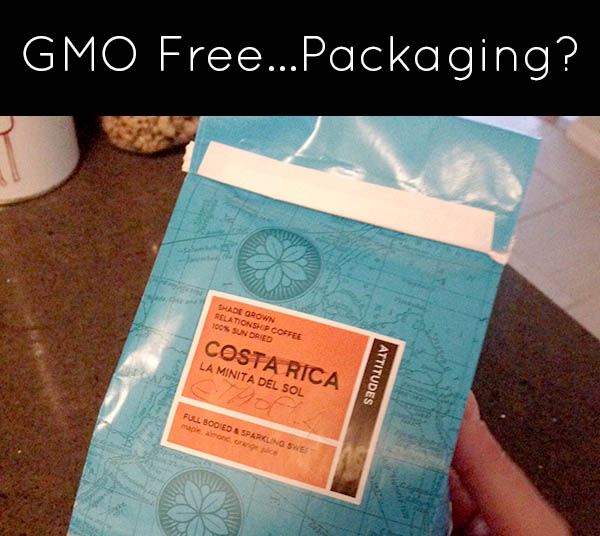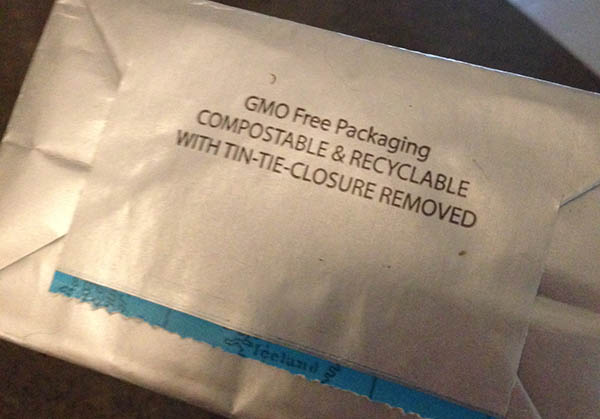
Written by Becky Striepe
Please imagine me using my best Jerry Seinfeld voice when I ask: What is the deal with GMO free food packaging?
But really. What is it? Why does it matter?
My husband came home with a bag of coffee, and when I emptied it into our burr grinder, I noticed this little label on the bottom:

You don’t eat the bag that your coffee came in, so who cares that it comes in GMO free packaging, right?
I think how much it matters depends on what it is that worries you about GMO foods. If you worry mostly about the potential health concerns, this might seem silly. But for me, the major worry with GMO crops isn’t about how it impacts my health directly.
GMOs in packaging:
Where would GMOs hide in food packaging? Two major GMO crops are corn and cotton. Either one can be used to create packaging. Cotton combined with paper fibers makes nice, strong paper packaging. If the packaging is made from bioplastic, chances are there’s GMO corn involved.
Why GMO free packaging is important:
So, why would you care about buying GMO free products if you’re not eating them? The short answer is pesticides. Read on for the long answer.
GMO free matters whether you’re eating a genetically modified organism, wearing it, crafting with it, or using it to package your coffee.
Let’s set aside worries about GMOs and direct health concerns for a minute, OK? Health seems to be at the center of the GMO debate, and I feel like this focus takes away from a much bigger, much more clear, and much more immediate problem with genetically modified crops. Pesticides. Pesticides, pesticides, pesticides.
Yes, when GMOs first came out, farmers could use fewer pesticides on these plants. And yes, it’s convenient that they can spray without worrying about killing the plants that produce food and pay their bills. The problem comes in over time, because weeds are adaptable.
When we plant row upon row of identical crop varieties and spray day after day with the same pesticides, we breed weeds that can withstand those pesticides. Or at least withstand them at the levels farmers are using them. That means spraying more.
Spraying more means more pesticides in our soil and more pesticide runoff into our lakes, rivers, and oceans. That means we are drinking pesticides in our water and contaminating aquatic habitats.
As more time has passed, spraying more has become less effective. The GMO solution? Create plants resistant to even more toxic pesticides and assuming that we’re not just escalating the problem and starting an even more toxic cycle starring new superweeds.
The soil and water contamination and habitat destruction that we’ve seen since the advent of GMO crops is the big problem that I think we need to talk more about. The direct environmental and indirect health impacts of GMOs are undeniable.
Bonus:
Listen to this Green Divas in the Garden podcast to learn more about how to support local farmers by visiting your local Farmers Market:
[dynamic-sidebar id=’Custom Widget 2′]